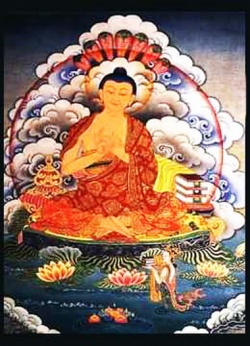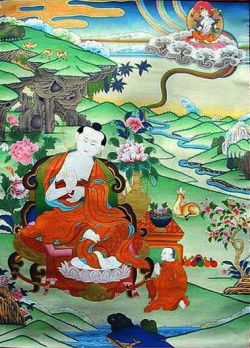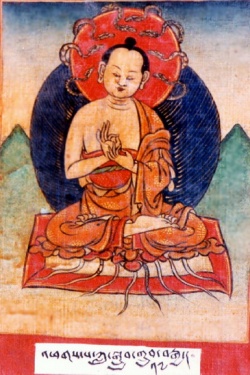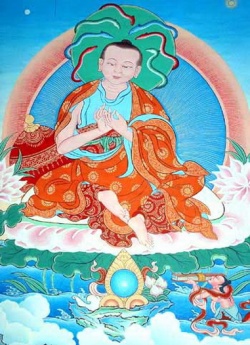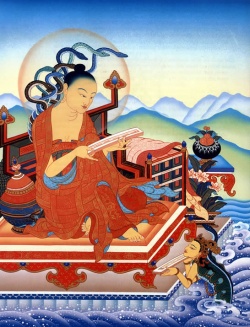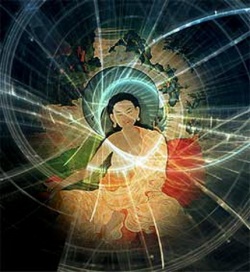Sunyata from "Heart Dweller"
If love leads the devotee to the point of the extinction of personality in the fire of truth, awareness can lead him to the point of seeing that ego does not really exist, and hence achieve the same goal of selflessness. Love melts the lover into the ocean of truth, there remain no traces of an “I”. Awareness, on the other hand, cuts through the illusion of a separate identity. It exposes the lie of ego: that it exists as a reality. Love melts ego away, while awareness is like turning on the light and seeing that there is nobody there. The outcome is the same in both cases, but the flavor of the path is different. One is more emotional, the other more insightful. The vocabularies of the two paths differ as a result. The path of love seeks union with the Beloved, while the path of awareness seeks the seeing of naked Reality. Just as prayer is the central practice in the path of love, meditation is the central practice in the path of awareness.
Buddhism, more than any other spiritual discipline, has developed meditation into a very fine art. Meditation is the center and the heart of all Buddhist schools. Without meditation there is really no Buddhism. And because of this Buddhism has more of a mental flavor than most other religions. It deals with the mind, and talks about the mind while the Sufis talk more of the Heart. This does not mean that the Buddhist Mind and the Sufi Heart are two different things. This is because when Buddhists say Mind they don’t mean what we usually understand to be mind. Also, when the Sufis mention the Heart they don’t mean what we call heart. Still the flavors of the two approaches are different because for the lower levels of spiritual experience there is a distinction between mind and heart.
My experience with the Buddhist path starts with the practice of Vipassana. It is the central practice in the Theravada tradition. The practice is just bare attention, being mindful of whatever my experience is. It is the main meditation practice that I have done for years. This meditation is not an easy practice by any means, although it sounds so. Just attending to whatever I experience puts me right away in touch with the first noble truth of Buddhism, the truth of suffering. Almost all this time there is suffering in my experience, whether in me or in the world around me. This suffering and pain is a prime cause for the lowering of awareness in each of us. We just want to avoid pain at any cost, and being asleep and unaware is the most effective means. But we cannot avoid pain without lowering our awareness. So cultivating awareness brings me face to face with suffering, mine and everybody else’s.
But suffering and pain are not the only difficulties in the practice of meditation. Beyond all the tricks and defenses of ego lie levels of experience and consciousness that are so subtle and so intangible that the meditator can be stuck for years without even knowing it. An accomplished and experienced meditation teacher is necessary, for this is a person who knows the terrain from experience and can guide the person who has never been to such places.
Vipassana is called “insight meditation,” for it develops and cultivates insight. At the beginning insight is psychological in nature. I see my ego patterns, my ways of handling my experience, my ways of avoiding reality, my conflicts, my emotional problems, and so on. So it is awareness of my personality or my ego. This is natural for this is what is there at the beginning.
However, awareness does not stop here. In fact, awareness does not need an object. It can be just pure awareness. It can be only aware of itself. So after a while, sometimes a very long while, the content of experience starts to slow and quiet down. With consistent practice my thoughts calm down, my emotions quiet down, and I become very calm, very still, very peaceful.
The level of experience shifts now that there is enough stillness for me to see more clearly. I become aware of this observer in me who is paying attention. I cannot pay attention without somebody paying attention to something. First I think this is ordinary and okay. I learn, however, that this observer is not really needed. The need for an observer is the need for ego to have a center, to make itself into a center of experience. So the observer is really none other than ego, or part of ego. I start seeing that awareness cannot develop more if it is centered. A center of awareness, an observer, always limits awareness, for it is always aware through a certain perspective, a certain point of view, from a certain direction. This somehow has a cramping effect on me. I become more tense instead of relaxed. An observer means there is tension in my awareness, it’s not open and free. So I turn my awareness backward and look at the observer. It jumps around, and awareness keeps following it. But awareness never finds any substantial reality to this observer. Regardless of how much I look there is really no observer. Sometimes it feels that it is only a thought, or an idea, or a place in my body, or a belief in its existence, but never a consistent identity. Not finding this observer makes it less real. The center of awareness relaxes its tense grip on my awareness. The ego-center, or the observer in this case, relaxes, spreads thinner, and slowly dissolves into the stillness. There is no more need for an observer.
Only stillness is left—fresh, clear, crisp and empty. Thoughts pass through it. Emotions pass through it. Experiences pass through it. But the stillness stays immaculate, just as the clear sky stays untouched as the clouds pass through it.
The winds blow
The rivers flow
The fires gnaw
But stillness is still still.
There is a feeling of lightness, of joy, of freedom. There is a sense of naturalness with a crystal kind of clarity, just as snow-covered mountains feel natural and clear. Awareness is no longer tense. It loses its attachment and active bent. It becomes more passive, like a receptacle. Everything comes to it. This is an important transition, for usually we exert a lot of effort to pay attention, and letting go and just being feels scary. I always thought before that I would miss seeing something if I did not actively look. But I saw that I only created strain this way, and also this active awareness is really more paranoia than anything else. When I let go, and trust that awareness is naturally there and I don’t have to make an effort, awareness becomes bigger, brighter, and easier. It’s like seeing everything, being aware of everything at the same time, effortlessly. It’s like a panoramic view, but not from above, nor from any direction. It’s like awareness is everywhere, and nothing is missed or overlooked. There is no concern or fear of missing something.
All kinds of experiences happen. Many new regions and spaces of the mind. Deep spaces, empty spaces, spacious spaces, soft spaces, dark spaces, light spaces, joyous spaces. The space itself, like stillness, becomes the object of awareness, and awareness goes deeper and deeper into it. Sometimes there is an uninterrupted space of stillness, or openness, without thoughts or feelings or any kind of content. It’s like a totally empty sky. Yet, slowly I discover that there is something like an atmosphere when the experience is happening. This atmosphere somehow colors the experience, gives it a certain flavor, which is reminiscent of myself. This insight cuts through the mental atmosphere and more openness manifests. Awareness becomes sharper, brighter. There is a feeling of less crowdedness, as if the atmosphere got thinner and lighter. I learn that such mental atmospheres are the action of concepts. I view reality through certain concepts. That’s what I have been doing all my life, and so has everybody else. We always experience reality through the filter of our concepts of reality. Even when thoughts, feelings, and sensations subside there remains the conceptual atmosphere through which I look at reality. It’s like instead of reflecting reality in a clear mirror, I do so using a colored mirror; so I believe that reality has that color instead of seeing that it is my mirror that is colored.
At superficial levels the concepts are in words and thought. Awareness can see through these easily. However, on subtler levels there are mental concepts without even thoughts. They are beliefs about reality taken as aspects of reality, so they become imperceptible. They are very subtle for they are all-pervading. It’s like being in a colored atmosphere that colors everything in it with the same color, including me. So I naturally believe that this color is an aspect of reality. There is no way to discriminate this color, this concept, this filter. The result is that reality is not seen directly, perception is still veiled. Reality is still not totally naked.
Here prajna, or intuitive awareness starts to develop. It is like a light that pierces through these concepts. Prajna is sometimes called discriminating wisdom, for it has the capacity to discriminate those subtle concepts that veil what is. Development of prajna is really the aim of Vipassana. Here, real insight starts to mature. It is no longer insight into the dynamics of the personality. It is insight into the nature of reality and the nature of consciousness.
Gradually prajna cuts through these concepts, like the sword of Manjusri cutting through the veils, revealing reality as it is—naked existence. No coloration, no filtering. It is direct perception. It is the experience of Sunyata, the void. Void does not mean empty of content like an empty container. It is just what is without the conceptual framework on top of it. It is direct perception without the naming or labeling of reality. It is reality without the presence of ego, without the presence of a center for experience. Experience is totally open—it does not have a center or a boundary. Everything is the same as before except that it is without my prejudices or beliefs. It is itself now.
• • • • •
I am sitting, meditating. Awareness of thoughts and feelings is sharp. A thought or a feeling is seen the moment it arises. It subsides quickly. Awareness intensifies. Not a thought, regardless of how subtle, escapes it. Yet there is no effort, there is no going after objects of awareness. There is a feeling of tremendous energy in my body that shoots up to the crown of the head. Here I open my eyes. Awareness is intense, clear. No ego is left. Sunyata prevails. There is only what is. Everything in the room looks as if I am seeing it for the first time. It shines with its own essence. Everything is just what it is, and it is totally complete in its nakedness. The lamp is totally packed with lampness. The music is just music, absolutely, and it is beautiful. Everything is as significant as everything else. A drop of water, with its own intrinsic nature, expresses the truth of reality.
A hanging drop
On the verge of extinction
Ready for the infinite
Without expecting
Small and itself
Totally existing
Reality
And reality’s expression.
Virgin freshness
Vibrant purity
Here now being
At the door of eternity.
Clear as a crystal
In stillness
Cleansing
The light.
An insignificant drop
Of ordinary water
A mudra
Of reality
It is itself
Yet it is the truth
It is finite
Yet the eye of infinity.
Totally empty
Totally full
A fair piece
Of the ineffable.
Everything shines with its own suchness. Just naked existence of what is. Every now and then “I” pops out, creates itself as if out of nowhere and claims the experience. Ego materializes as an identity, as a center. This interrupts the direct perception, and sunyata is no longer pure. It becomes more like interrupted intervals of sunyata, the interruption made by ego popping its head out and saying, “Here I am.” So I start writing.
Everything I think or do is to create an “I” that does not exist. Not that it is better if it did not exist, but that is the reality: “I” does not exist. Reality just is, nothing. If anything, then it is me which prajna alone can cut away. What is left is a thought, or a thought looking at a thought. A feeling. A car driving by.
My friend Ron. I feel I want to tell Ron. It is important for me. So back to me. From sunyata to me.
So, no matter what I say, I will just come back to me, and since me, as “me,” is only a creation of “me,” .... who said that?
So.
This is funny. I want to say that I know what sunyata is, but where? It’s all gone, the moment I have this thought.
Sunyata has an infinite power to free, not to free somebody, but to free freedom from somebody who wants or thinks of freedom.
Ego = self = identity, is the opposite of sunyata.
Sunyata has no limits. Its depth is unimaginable. I won’t say I can’t imagine it, because there is nobody to imagine anything anymore.
It is amusing, this “I” that comes in and out every now and then which seems to claim some sort of right to be here.
The thing, friend, is not that it is here or there; it is that there is no you in the first place. So where does this statement come from?!
There is a tendency to glorify, but there is nobody to glorify. There is only glory. Glory is golden with green haloes around it.
There are times when
I am = zero
That has the effect of an atom bomb. Who says so? Ego, of course.
Sunyata is there at the edge of ego, right at the zero edge of identity.
“The ‘I’ seems to have some sort of strength.”
A thought! Another trick of ego.
Sunyata is gone when ego tries to play a trick on itself that it exists.
The interesting thing is that I am not writing this for me; for, frankly speaking, this me does not seem to be.
Trying to capture sunyata, by writing about it, is always at the edge of sunyata and self. It is very tricky. It is very tricky—the moment there is an identity to an action then there is no sunyata.
We must not forget that ego, too, is sunyata, for sunyata is.
Sunyata is important, but not to me personally, for “I” is more of an appearance than anything else. Right now, for instance:
“I” = “Belief that I know sunyata.”
This “I” is mixed up with another bunch of “I”s, all assuming that they exist. And so they create problems. But, in fact, they are problems for nobody. And, in fact, they are not problems. And, in fact, they are not. And, in fact.
In the Heart Sutra, Avaloketisvara tells Shariputra, “Form is emptiness, emptiness is form.” In sunyata, form is empty. It is totally empty of any conceptual significance. No association follows the perception. It is just what it is, nothing. For making it a thing is the function of concepts. On the other hand, each form assumes its full substantiality, becomes full to the brim with itself. So this emptiness is not really empty, it is quite full, but full with its own reality and not what I lay on it. So the bed is full, is packed with bedness. The dark is one hundred percent full with darkness. Each form, because it is empty of concepts, takes the full measure of its nature. The quality of beingness in sunyata is of being awake: bodhi. It is not that I am awake. It is more like reality is awake. Everything awakes to its own nature. It is a sense of openness, brightness, naturalness. My eyes are wide open, shiny. My face shines with an inner light, so does everything else. A feeling of total presence, of concreteness. Everything shines and is luminous, yet stays just itself. There are no additions to reality. It is just manifesting its intrinsic nature, now that it is free from the tyranny of my beliefs and concepts about it. Everything lightens up when ego relaxes its grip. Everything wakes up when ego is gone, gate, gate. So the Heart Sutra says: Gate gate, paragate, parasamgate, bodhi, swaha. So be it.
Source
From Heart Dweller
© 1973 A-Hameed Ali – All rights reserved
ahalmaas.com
